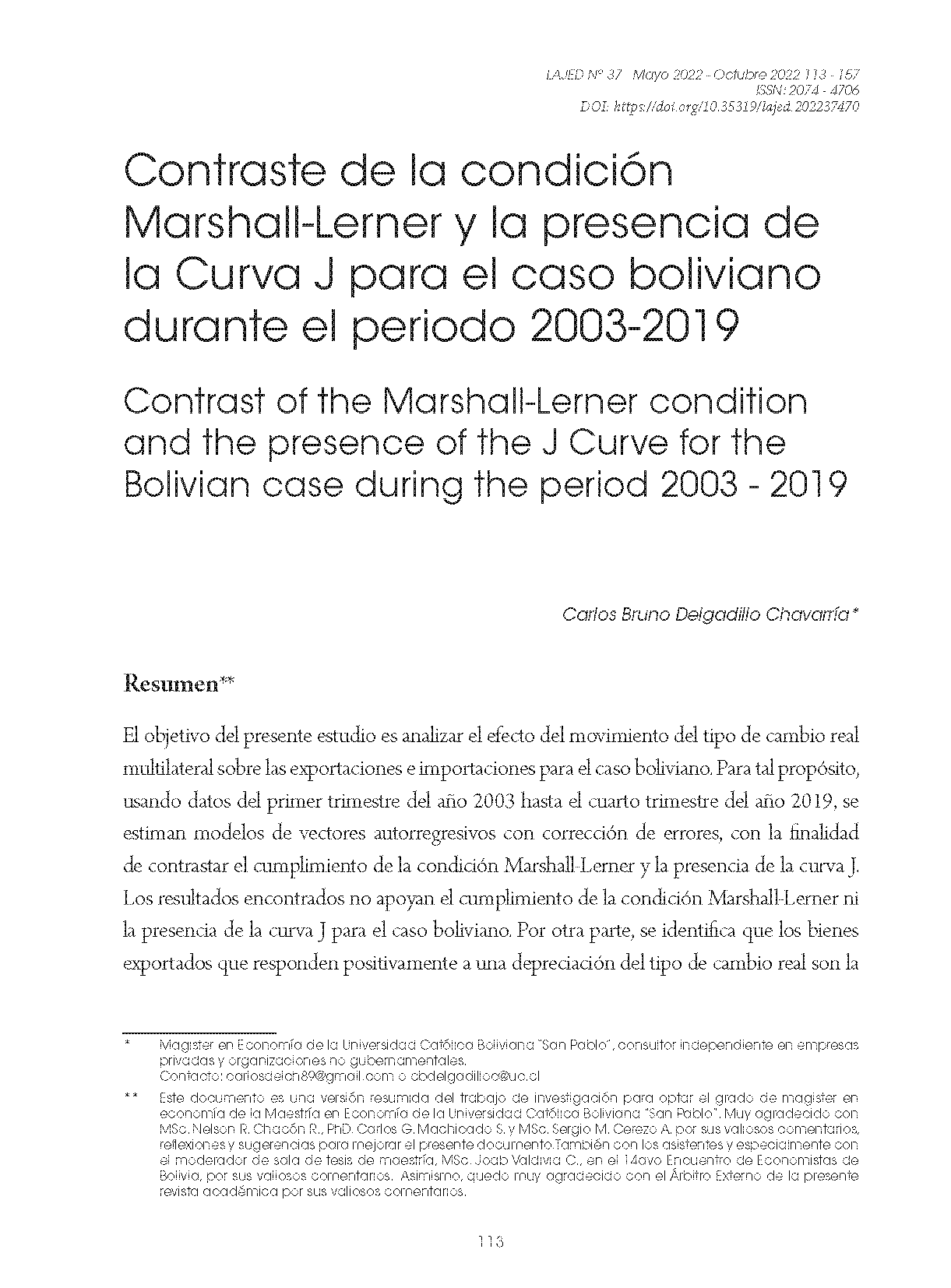Contrast of the Marshall-Lerner condition and the presence of the J Curve for the Bolivian case during the period 2003 - 2019
DOI:
https://doi.org/10.35319/lajed.202237470Keywords:
Marshall-Lerner condition, J curve, trade balance, real exchange rateAbstract
The aim of this document is to analyze the effect of the movement of the multilateral real exchange rate on exports and imports for the Bolivian case. For this purpose, using data from the first quarter of 2003 to the fourth quarter of 2019, autoregressive vector models are estimated with error correction, in order to calculate price elasticity’s of demand for exports and imports for different aggregate and disaggregated categories of goods. This allows us to verify the fulfillment of the Marshall-Lerner condition and the presence of the J curve. The results found support neither the fulfillment of the Marshall-Lerner condition nor the presence of the J curve for the Bolivian case. On the other hand, the exported goods that respond positively to a depreciation of the real exchange rate are wood and tin. While the imported goods that respond negatively to a depreciation of the real exchange rate are intermediate goods and raw materials for the agricultural sector, and capital goods for industry and transport equipment.
Downloads
References
Alvarado, J. (2018, 22 de mayo). Bolivia ya debe más de $us 16 mil millones. Los tiempos. https://www.lostiempos.com/oh/entrevista/20170522/julio-alvarado-bolivia-ya-debe-mas-us-16-mil-millones
Arandia, H. y Laura, L. (2018). Impacto de movimientos cambiarios en el comercio exterior. Cuadernos de Investigación Económica Boliviana, II (2), 87-142.
Bahmani, M., Harvey, H. y Hegerty, S. W. (2013). Empirical tests of the Marshall-Lerner condition: A literature review. Journal of Economic Studies, 40(3), 411-443.
Bahmani-Oskooee, M. y Ratha, A. (2004). The J-Curve: A literature review. Applied Economics, 36(13), 1377-1398. https://doi.org/10.1080/0003684042000201794
Bahmani-Oskooee, M. y Hegerty, S. W. (2010). The J- and S- curves: A survey of the recent literature. Journal of Economic Studies, 37(6), 580-596.
Bahmani-Oskooee, M. y Niroomand, F. (1998). Long-run price elasticities and the Marshall-Lerner condition revisited. Economics Letters, 61(1), 101-109.
Banco Central de Bolivia (2009). Informe de política monetaria, julio de 2009. La Paz, Bolivia.
Banegas-Rivero, R. A. (2016). Rol de la política cambiaria en el sector externo: la condición Marshall-Lerner en Bolivia. Economía Coyuntural, Revista de Temas de Perspectivas y Coyuntura, 1(1), 1-23. https://ideas.repec.org/a/grm/ecoyun/201601.html
Bird, G. (2001). Conducting macroeconomic policy in developing countries: Piece of cake or mission impossible? Third World Quarterly, 22(1), 37-49. https://doi.org/10.1080/713701139
Boyd, D., Caporale, G. M. y Smith, R. (2001). Real Exchange Rate Effects on the Balance of Trade: Cointegration and the Marshall-Lerner Condition. International Journal of Finance & Economics, 6(3), 187-200.
Bustamante, R. y Morales, F. (2009). Probando la condición de Marshall-Lerner y el efecto Curva-J: evidencia empírica para el caso peruano. Revista Estudios Económicos, (16), 103-126.
Bustos, P. y Aguilar, R. (2017). Estimando la condición Marshall-Lerner para la economía boliviana: 2003-2014. Revista de Análisis del BCB, 26(1), 103-144.
De Sousa, D. y Zeballos, D. E. (2015). La política cambiaria en Bolivia, objetivos y efectividad. Revista de Análisis del Banco Central de Bolivia, 23, 63-102.
Dornbusch, R. (1993). La macroeconomía de una economía abierta. Barcelona: Antoni Bosch.
Franco, A. (2016). El rol conjunto de la política fiscal, monetaria y cambiaria en el crecimiento económico de Bolivia. Revista de Análisis del Banco Central de Bolivia, 25(2), 111-140.
Hernández, P., Rivero, A. y Frías, I. (2012). El tipo de cambio real, el ingreso nacional y el ingreso foráneo en la determinación de la balanza comercial en Bolivia: 1992-2011. Revista Nicolaita de Estudios Económicos, VII(2), 27-46.
Jamilov, R. (2011). J-Curve Dynamics and the Marshall–Lerner Condition: Evidence from Azerbaijan. Transition Studies Review, 19(3), 313-323.
Jemio, L. C. (2008, 14 de julio). El boom exportador en Bolivia. Desarrollo sobre la mesa. https://inesad.edu.bo/dslm/author/lcjemio/
---------- (2013). Comportamiento de las importaciones en Bolivia. http://dicyt.uto.edu.bo/observatorio/wp-content/uploads/2019/04/CNC-Comportamiento-deimportaciones-Bolivia-2013.pdf
---------- (2015, 3 de agosto). Apreciación Cambiaria en Bolivia. Desarrollo Sobre la Mesa. https://inesad.edu.bo/dslm/2015/08/apreciacion-cambiaria-en-bolivia/
---------- (2019). Un régimen cambiario apropiado para Bolivia. Desarrollo sobre la mesa. https://inesad.edu.bo/dslm/author/lcjemio/
Johansen, S. (1988). Statistical analysis of cointegration vectors. Journal of Economic Dynamics and Control, 12(2), 231-254. https://doi.org/10.1016/0165-1889(88)90041-3
Loza, G. (2000). Tipo de cambio, exportaciones e importaciones: El caso de la economía boliviana. Revista de Análisis del BCB, 3(1), 7-40.
Lütkepohl, H. (2005). Nueva introducción al análisis de series temporales múltiples, Texto original. Springer-Verlag. https://www.springer.com/gp/book/9783540401728
Muriel, B. (2015, 9 de marzo). ¿A quiénes beneficia la bonanza económica? Desarrollo sobre la mesa. https://inesad.edu.bo/dslm/2015/03/bmuriel22015/146
Ouliaris, S., Pagan, A. y Restrepo, J. (2018). Quantitative Macroeconomic Modeling with Structural Vector Autoregressions. https://www.eviews.com/StructVAR/structvar.html
Sek, S. K. y Har, W. M. (2014). Testing for Marshall-Lerner Condition: Bilateral Trades between Malaysia and Trading Partners. Journal of Advanced Management Science, 2(1), 23-28.
Urbasos, I. (2019). ¿Qué hará Bolivia con su gas natural cuando Brasil y Argentina ya no lo necesiten? Universidad de Navarra, Global Affairs. https://www.unav.edu/web/globalaffairs/detalle/-/blogs/que-hara-bolivia-con-su-gas-natural-cuando-brasil-y-argentinaya-no-lo-necesiten
Wanderley, F., Vera, H., Benavides, J., Gantier, M. y Martínez, K. (2018). Hacia el desarrollo sostenible en la región andina: Bolivia, Perú, Ecuador y Colombia. Instituto de Investigaciones Sociales y Económicas de la Universidad Católica Boliviana San Pablo.

Downloads
Published
How to Cite
Issue
Section
License
Copyright (c) 2022 Latin American Journal of Economic Development

This work is licensed under a Creative Commons Attribution-NonCommercial 4.0 International License.





